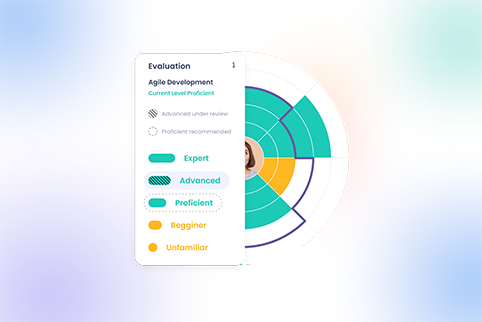
The world of work is changing, and the most in-demand jobs from today didn’t even exist 15-20 years ago. The situation is not much different with skills, with their half-life estimated to be around 5 years — meaning at least some skills from 2019 are no longer relevant now.
And this trend will only continue in the future: “Since 2015, job skillsets have changed by 25%, and will continue to shift by 65% by 2030 globally,” according to LinkedIn data.
With that in mind and with the awareness that ‘certainty’ and ‘stability’ should no longer be associated with ‘work’ in the new AI-driven world, let’s take a closer look at some of the fastest-growing jobs and markets and the role of L&D in filling these in-demand positions.
What are the fastest-growing jobs in the world?
We’ve looked at data and insights from the US Bureau of Labor Statistics, LinkedIn, and HRO Today to better understand what are some of the fastest-growing jobs both now and in the next 10 years in the United States.
Fastest-growing jobs in sustainability
It’s hardly surprising that sustainability is one of the fastest-growing job sectors. Governments, businesses, and individuals have become increasingly aware that environmental issues like climate change and pollution need to be addressed urgently and strategically, thus leading to the emergence of more sustainability-oriented initiatives.
However, this transition requires a brand-new set of (green) skills and has created a high demand for professionals who have the necessary expertise in areas like renewable energy, environmental science, and green tech.
Some of the fastest-growing jobs in the sustainability field include:
- Sustainability managers: Develop, implement, and oversee strategies and initiatives that help organizations minimize their environmental impact, promote social responsibility, and ensure long-term economic growth.
- Sustainability analysts: Conduct research and data evaluation to determine an organization’s performance on multiple levels — environmental, social, and economic. Most common skills: Sustainability Reporting, Corporate Social Responsibility.
- Environmental health safety managers: Oversee the development and implementation of policies and procedures to ensure people and business departments comply with environmental regulations and occupational health and safety standards. Most common skills: Environmental Compliance, Hazardous Waste Management, Environmental Management Systems.
- Wind turbine service technicians: Inspect, repair, and maintain wind turbines to ensure their optimal performance and efficiency over time. Most common skills: Electrical Troubleshooting, Hydraulic Systems Maintenance, Climbing and Rope Access Techniques.
- Solar photovoltaic installers: Assembly, install, and maintain solar panel systems on residential homes, commercial buildings, industrial properties, etc. Most common skills: Electrical Wiring and Connections, Photovoltaic System Design, Inverter Installation and Configuration.
Fastest-growing jobs in tech
With the increasing speed of digitalization and the popular move to cloud-based solutions, we’re now living in a world where everything is going online, and brands that don’t have a presence in this space can struggle to keep up.
But this move to tech-based solutions also comes with a different threat — cybercrimes in all forms: phishing, malware, identity theft, hacking, etc. And with the rise of AI, these have reached a whole new level. Just look at the recent example from Hong Kong:
A finance worker was tricked into paying $25.6 million to scammers by a ‘deepfake’ video call featuring AI copies of his co-workers. The employee transferred the money to the criminals after they used artificial intelligence software to imitate the worker’s superiors, including his UK-based chief financial officer.
— The Telegraph
And since AI is such a hot topic, especially generative models, it’s only natural that the fast pace of development and adoption in this area also leads to an increase in demand for top talent.
Some of the fastest-growing jobs in tech include:
- Cybersecurity analysts: Monitor, detect, and respond to security threats or other incidents that target an organization’s computer networks and systems. Most common skills: Penetration Testing, Endpoint Security Management, Malware Analysis.
- Security Operation Center (SOC) analysts: Investigate alerts, analyze security events, and coordinate incident response activities to mitigate risks and minimize the impact of cyberattacks. Most common skills: Security Tools Management, Network Traffic Analysis, Cyber Threat Intelligence Analysis.
- AI consultants: Act as advisors for businesses and help them find strategic ways to implement AI technologies so that processes, decision-making, and innovation are improved. Most common skills: Machine Learning, Deep Learning, Natural Language Processing (NLP).
- AI engineers: Develop, program, and train complex algorithms networks, which are the basis of AI solutions, and strive to make them behave similarly to the human brain. Most common skills: Machine Learning, Deep Learning, Natural Language Processing (NLP).
- Software engineering analysts: Analyze a wide range of software systems and technologies, looking for improvement areas and aiming to optimize the efficiency of software development lifecycles. Most common skills: Software Testing and Quality Assurance, Software Design Patterns, Continuous Integration and Deployment.
Fastest-growing jobs in healthcare
Various factors, from a shift in lifestyle choices to stress, have contributed to a current situation in which people are living longer but aren’t necessarily healthier — with both physical and mental disorders on the rise. In fact, according to the World Economic Forum:
90% of workers are affected by mental health challenges, either personally or through someone they are close to.
That, combined with the financial struggles of the health care system in many countries means that jobs in this area are in high demand, with some of the fastest-growing roles including:
- Nurse practitioners: Coordinate patient care and are able to provide primary and specialty healthcare services to patients of all ages. Most common skills: Prescription Management, Immunization Administration, Diagnostic Test Interpretation.
- Medical and health services managers: Oversee the operations of healthcare facilities, such as hospitals, clinics, or nursing homes, ensuring efficient and effective delivery of services. Most common skills: Healthcare Administration, Healthcare Policy and Regulations, Staff Management and Leadership.
- Epidemiologists: Investigate patterns and causes of diseases and other public health threats to prevent and control their spread. Most common skills: Infection Control, Patient Safety, Electronic Medical Record (EMR).
- Physical therapist assistants: Work under the guidance and supervision of physical therapists to provide rehabilitative services to patients with various injuries and illnesses. Most common skills: Rehabilitation, Inpatient Care, Epic Systems.
- Home health and personal care aides: Provide essential assistance to individuals who need support with daily tasks due to age, illness, or disability. Most common skills: Mobility Assistance, Assistance with Medical Equipment Usage, Emergency Response Procedures.
Fastest-growing remote jobs
Despite the limitations and challenges of hybrid and remote environments, the truth is there’s no going back to the old way of doing work — which can be seen in the huge demand (and increasing supply) of remote jobs.
The benefits aren’t only for employees, either. This additional flexibility helps organizations access a wider pool of candidates and encourages them to nurture a truly international and inclusive workforce.
According to HRO Today, some of the fastest-growing remote jobs are:
- Sales representatives: Identify potential customers, present product or service information, address customer inquiries and concerns, and close deals. Most common skills: Customer Relationship Management (CRM), Industry Trends Analysis, Territory Management.
- Account managers: Manage relationships with existing clients and customer accounts by understanding client needs, addressing concerns, and ensuring overall satisfaction. Most common skills: Needs Assessment, Cross-Selling and Upselling, Customer Retention Strategies.
- Client services specialists: Provide support and assistance to clients and customers, ensuring they enjoy a positive experience throughout their journey with the company.
- Business development managers: Identify new business opportunities, build relationships with potential clients or partners, and grow the company’s market reach. Most common skills: Market Research and Analysis, Sales Strategy Development, Financial Analysis.
- Training and development managers: Collaborate with (learning) experts to design and create effective learning programs and materials, which meet diverse employee learning needs at different levels and functions. Most common skills: Training Program Design, Instructional Design, Training Delivery Methods.
What can organizations do when the supply fails to meet the talent demand for the fastest-growing jobs?
It’s no secret that talent and skills shortages are real and already impacting modern businesses in many ways. And perhaps the best strategic answer in the face of this rising challenge is to double down on investments in L&D initiatives and skill development.
In other words, companies should shift their focus to training and developing the skills required for emerging job roles internally instead of looking after them externally. This is also emphasized by Becky Schnauffer, the Head of Global Clients at LinkedIn Talent Solutions:
Interestingly, many of the fastest-growing roles today did not even exist 20 years ago — which may account for why some businesses are struggling to find talent with the skills they need. With so many roles emerging in new areas, such as generative AI, learning and development is now a strategic imperative for businesses.
But how can organizations design effective upskilling and reskilling programs to prepare people for emerging and fast-growing roles? The first step is developing a thorough understanding of the skills already available within your workforce, as well as important gaps.
This is where skills-based approaches are a game-changer. By prioritizing skills and leveraging skills data and insights, you can design the entire talent management journey and workforce planning strategy based on a single source of truth — and more easily align all efforts (e.g., hiring, growth opportunities, promotions, redeployment) with the larger business objectives.
Once skill gaps are identified and combined with insights on the growing skill trends in your industry, your HR department can collaborate with L&D and people managers to select the best growth and development opportunities — which can now be tailored to the specific (skill) needs of each employee or team.
Other benefits of investing in L&D and skill development
In addition to addressing talent and skill shortages and helping companies to fill fast-growing jobs, there are other advantages of focusing your attention and resources on L&D initiatives:
- Prioritizing career development and providing employees the growth opportunities they want is one of the best ways to improve overall retention — which is more important than ever in 2024, with 49% of hiring managers (in the UK) expecting attrition levels to rise this year.
- Fosters a culture of growth and continuous learning, in which, in addition to learning, people are encouraged to unlearn and relearn (skills), which will be increasingly important in a work environment where job titles and requirements are changing.
- Helps develop a brand identity and status of a high-quality and attractive employer, which naturally results in more top talent applying and choosing to work for your organization and helping to fill those in-demand roles.
- In addition to helping employees remain relevant and have up-to-date skill sets, investing in L&D will also drive higher and faster levels of innovation, ensuring the company is staying ahead in the competitive business landscape and responding effectively to emerging challenges.
Final thoughts
As the emergence of fast-growing jobs is changing the modern workplace, it’s crucial for HR strategists and business leaders to recognize this evolution in the job market and act accordingly.
As the demand for new and specialized skills increases, investing in robust L&D programs can be one of the most effective ways of addressing the challenge of filling these high-growth positions.
With Nestor, you can use the power of skills to provide more personalized and impactful growth opportunities to your people and ensure their development is always aligned with your shifting business priorities.
Schedule a free demo to learn how our skills-based platform can take your L&D initiatives and other talent management processes to the next level through the power of skills.
Frequently-Asked Questions (FAQs) about the fastest-growing jobs
Which careers are growing fastest?
Currently, the fastest-growing careers are in IT (especially AI and Cybersecurity), sustainability, healthcare, and data science, among others.
Which job is the best for the future?
A job in one of the fields or sectors listed above is a safe bet for lucrative and long-term professional success.
It’s also worth pointing out that jobs relying on soft or human skills will become increasingly important as the adoption of AI and automation increases, so that’s something both employees and employers should focus on.
What jobs are at risk of being replaced by AI?
While AI is not a buzzword anymore and its adoption in the modern workplace is picking up speed fast, it’s still too early to know for sure which jobs will be replaced. Many years ago, it was thought that creative roles were safe and yet generative AI models seem to have changed that opinion, at least to some extent.
With all of that in mind, jobs like coding and programming, content creation and journalism, some roles in the legal industry, accountants, and customer service agents are expected to be either partially or fully replaced by AI over time.







